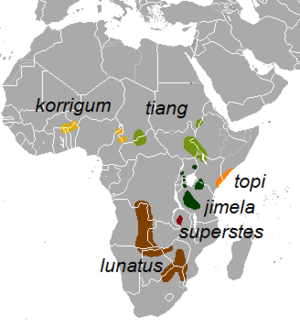Korrigum facts for kids
Quick facts for kids Korrigum |
|
|---|---|
 |
|
| In Waza National Park, Cameroon | |
| Conservation status | |
| Scientific classification |
|
| Kingdom: | Animalia |
| Phylum: | Chordata |
| Class: | Mammalia |
| Order: | Artiodactyla |
| Family: | Bovidae |
| Subfamily: | Alcelaphinae |
| Genus: | Damaliscus |
| Species: | |
| Subspecies: |
D. l. korrigum
|
| Trinomial name | |
| Damaliscus lunatus korrigum (Ogilby, 1837)
|
|
 |
|
| Range in yellow | |
| Synonyms | |
|
|
The korrigum (Damaliscus lunatus korrigum) is a type of large African antelope. It is also known as the Senegal hartebeest. The korrigum is a subspecies of an animal called the topi.
Contents
What is the Korrigum?
Taxonomy is how scientists classify living things. It helps us understand how different animals are related.
In the 1820s, a British trip explored the Sahara Desert. They went to an old kingdom called Bornu. The explorers brought back the horns of an antelope. Local people there called this animal a korrigum.
A scientist named William Ogilby studied these horns. He wrote about them in a science journal. In 1837, he officially named the korrigum as a new species.
What Does a Korrigum Look Like?
The korrigum is very similar to another topi subspecies called the tiang. Scientists used to think they were different. They thought the korrigum had a bushier tail. Its fur, called pelage, was also thought to be more reddish.
The tiang was believed to have bigger dark patches of hair on its legs. However, scientists later found that the korrigum and tiang look almost the same. It is very hard to tell them apart just by their size or shape.
Where Do Korrigums Live and Are They Safe?
Korrigums used to live across a large part of Africa. Their home stretched from southern Mauritania to western Chad. But their numbers have dropped a lot since the early 1900s. This happened because of hunting and cattle taking over their land.
The IUCN is a group that studies how safe animals are. They said in 1998 that korrigums might no longer live in many countries. These include Mauritania, Mali, Senegal, and the Gambia. They also might not be in northern Togo, Nigeria, or western Chad.
How Many Korrigums Are Left?
In 2004, scientists estimated the number of korrigums. They looked at two national parks: Waza National Park and Pendjari National Park. They thought there were about 2,650 animals in these parks.
Because of these numbers, the IUCN said the korrigum was 'vulnerable' in 2008. This means it was at risk of becoming endangered. In 2016, the IUCN changed its mind. They used the same 2004 numbers but new rules. They now say the korrigum is 'endangered'. This means it faces a very high risk of dying out.
The IUCN believes that most korrigums live in these two parks. However, this might be a misunderstanding of the original report. That report said 95% of the korrigum's home in Benin was in protected areas.
Where Can You Find Korrigums Today?
Sadly, the number of korrigums in Waza National Park dropped before 2007. But in 2013, korrigums were found living in northeast Ghana.
Topi populations also live in Zakouma National Park in Chad. They are also found in hunting areas around the park. The topi here are sometimes called korrigum or tiang.
There are also many korrigums in the Niwa area. This area is next to the Bouba Ndjida National Park in Cameroon. You can also find them throughout the park itself.


